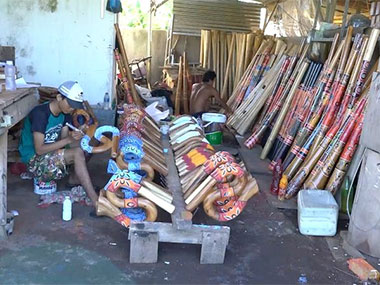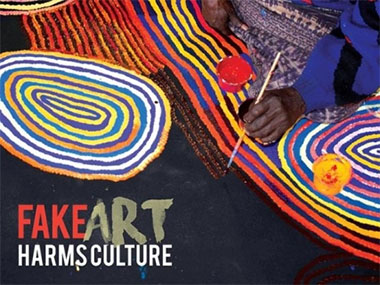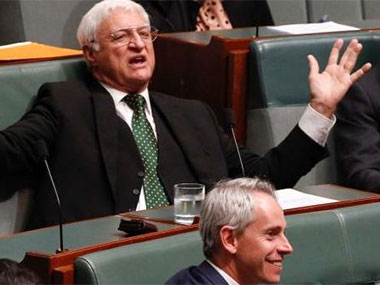DIGITAL CODES

Channel 9's '60 Minutes' captures the industrial scale of artefact faking in Bali
Jeremy Eccles | 27.06.18
Author: Jeremy Eccles
News source: Press Release
The Australian Government this week announced that it will commit $150,000 to a pilot program to test digital codes to label authentic Aboriginal and Torres Strait Islander products. The move is the latest step in the fight against inauthentic Indigenous art and follows from the 'Fake Art Harms Culture' campaign, launched in August 2016 led by the Indigenous Art Code, the Arts Law Centre of Australia and Copyright Agency, and the subsequent inquiry by Australian Competition and Consumer Commission (ACCC) into inauthentic products presented to consumers which are misleading under Australian Consumer Law. A court case is imminent.
The pilot will be conducted by Desart in Alice Springs in collaboration with the Copyright Agency, Viscopy and the Federal Department of Communications and the Arts. It will be implemented in three or more remote Indigenous-owned art centres – presumably in the Desert areas - and will start in the first half of 2019.
Announcing the funding, Federal Minister for the Arts, Mitch Fifield said, “This initiative aims to assist consumers to make informed and ethical purchases and will increase economic and cultural opportunities for Aboriginal and Torres Strait Islander artists and designers. The digital codes will allow consumers to track the artwork’s journey from a remote community to the store shelf, and see information on provenance and the artist.”
Coincidentally, on Sunday 17th June, the '60 Minutes' program tackled the subject of fake artefacts – note, not fake art. On it, one Balinese business owner proudly boasted that he and his 100 workers were experts in Aboriginal art after being taught many years ago by an Australian businessman. “We put sticker ‘Made from Australia’, ‘Made in Australia’, the shop owner revealed about some of his orders. “Maybe your customer don’t know Made in Bali.”
And this is the mystery about the Government's funding: Why have they seemingly failed to distinguish between great art from Australia's art centres and tourist tat from Indonesia???
One answer is certainly that they have no knowledge of the history of this issue. Back in the 1990s, a mob called NIAAA, the National Indigenous Arts Advocacy Association spent millions developing an Aboriginal tick (or was it a boomerang?) not unlike Nike's, which was going to identify Aboriginal-produced art and artefacts. There was annual Federal funding of more than $500,000, the Australia Council paid the association $1 million over three years, and ATSIC gave NIAAA more than $1.2 million over eight years. In 2002, it was deregistered, having done little more than collect 9c a T-shirt which manufacturers wanted to sell as Indigenous. I can't recall any art ever getting a tick.
Are we going down the same road again, Minister Fifield?
Another problem – all too common in the world of Aboriginal art – is that no one's consulted the dealers, who are all-too-often regarded as the enemy by the purists at the politically correct heart of the movement. None I consulted had heard about the pilot, though they are at the receiving end of the art. So, does this raise questions about the increasing tendency of art centres to sell directly to the public or set up their own galleries in town – like the APY Art Centre Collective?
One dealer found it odd that this scheme was announced ahead of the Senate Committee report that's investigating fakery; and a couple pointed out that art from art centres already had digital codes attached by Australia Post, which followed packages all the way to the cities.
The experienced Christopher Hodges from Utopia Gallery in Sydney was blunter: “Everyone is confusing the issue. This is to do with non-Indigenous, non-Australian people producing things that look like Aboriginal artefacts, it's not about the art at all. It's about souvenir shops in Australia filled with Indonesian and other Asian products that try to pass off as the real thing. The Indonesians and others have been making tourist tat for years and tourist shops are happily flogging it to unsuspecting tourists.
“With the art, a branding scheme might work, like the Woolmark label,….if everyone will pay the little fees”.
In Hobart, Art Mob's Euan Hills added, “I have not heard anything about this. I actually sell more non-art centre artwork than art centre artwork, so where does such a strategy fit? Both sources are equally as authentic but no one has asked for my input”. And, given the suggestion that this pilot project is only about non-authentic Aboriginal art, Hills fears it will “instill doubt and fear into the minds of the public. Better to focus on the wondrous aspects of Australian Indigenous art. Get Border Force to stop imports of fake artefacts, fake fashion, fake jewellery, fake immigrants and fake politicians”!
URL: https://www.aph.gov.au/inauthenticart
Share this:
»  del.icio.us
»
del.icio.us
»  Digg it
»
Digg it
»  reddit
»
reddit
»  Google
»
Google
»  StumbleUpon
»
StumbleUpon
»  Technorati
»
Technorati
»  Facebook
Facebook
Contact Details

The campaign poster which kicked off the Fake Art project

MP Bob Katter, attempting to introduce a Bill to Parliament which would add a new division in the Australian Consumer Law that relates to Unfair Practices
Further Research
News Tags: Arts Law Centre of Australia | Bob Katter | Border Force | Copyright Agency | Fake Art | Indigenous Art Code | Jeremy Eccles | Mitch Fifield | National Indigenous Arts Advocacy Association | NIAAA
News Categories: Feature
News Archive
- 01.08.18 | A SENSE OF PLACE
- 30.07.18 | The Long Forgotten Dream
- 29.06.18 | INTERNATIONAL ACTIVITY
- 24.06.18 | Blak Markets Back in Sydney
- 22.06.18 | “I am the old and the new”
- 19.06.18 | SAMUEL NAMUNJDJA
- 15.06.18 | DARK EMU
- 14.06.18 | WIK v TAREE
- 08.06.18 | WARS & MASSACRES
- 03.06.18 | NY “Goes Ballistic” over Aboriginal Art
- 30.05.18 | THE PLAY'S THE THING.....
- 25.05.18 | Red Ochre Time Again
- 24.05.18 | THE LOCKHART BRAND IS BUOYED UP
- 03.05.18 | THE WYNNE'S A WINNER AGAIN
- 02.05.18 | NATSIAA FINALISTS ANNOUNCED
Advertising

